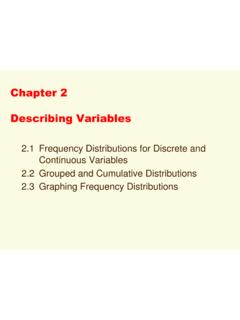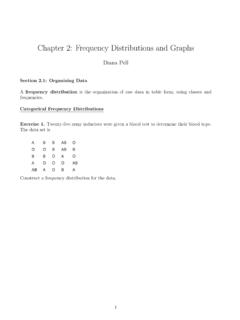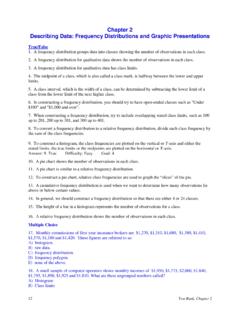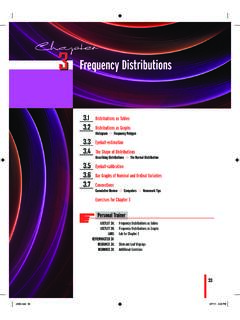Transcription of Hybrid Statistics Frequency Distributions and Their Graphs
1 1 | P a g e Hannah Province Mathematics Department Southwest Tennessee Community College Hybrid Statistics chapter 2 Section Frequency Distributions and Their Graphs Objectives: Construct Frequency Distributions Construct Frequency histograms Frequency polygons Relative Frequency histograms Ogives Frequency distribution A Frequency table partitions data into classes or intervals and shows how many data values are in each class. The classes or intervals are constructed so that each data falls into exactly one class.
2 If the Frequency is converted into percentage of individuals then we have a relative Frequency table. Steps to Constructing a Frequency distribution 1. Decide on the number of classes. a. Usually between 5 and 20; otherwise, it may be difficult to detect any patterns. The problem will usually tell you how many classes. 2. Find the class width. a. Determine the range of the data. (Highest Obs. Lowest Obs.) b. Divide the range by the number of classes. c. Round up to the next convenient number.
3 3. Find the class limits. a. You can use the minimum data entry as the lower limit of the first class. b. Find the remaining lower limits (add the class width to the lower limit of the preceding class). c. Find the upper limit of the first class. Remember that classes cannot overlap. d. Find the remaining upper class limits. 4. Count each data entry in the row of the appropriate class to find the total Frequency , f, for each class. 2 | P a g e Hannah Province Mathematics Department Southwest Tennessee Community College Determining the Class Limits (Upper and Lower) Determining the Midpoint (In section the Midpoint will be denoted by the letter x) Midpoint of a class Determining the Relative Frequency Relative Frequency of a class Portion or percentage of the data that falls in a particular class.
4 Determining the Cumulative Frequency Cumulative Frequency of a class The sum of the Frequency for that class and all previous classes. (Lower class limit) (Upper class limit)2 59 115 171 Class width = 56 + + 6 1319 Lower Class Limit Upper Class Limit 3 | P a g e Hannah Province Mathematics Department Southwest Tennessee Community College Example: Constructing a Frequency distribution The following sample data set lists the prices )in dollars) of 30 portable global positioning system (GPS) navigators.
5 Construct a Frequency distribution that has seven classes. 90 130 400 200 350 70 325 250 150 250 275 270 150 130 59 200 160 450 300 130 220 100 200 400 200 250 95 180 170 150 Solution: 4 | P a g e Hannah Province Mathematics Department Southwest Tennessee Community College Graphs of Frequency Distributions Frequency Histogram A bar graph that represents the Frequency distribution . The horizontal scale is quantitative and measures the data values.
6 The vertical scale measures the frequencies of the classes. Consecutive bars must touch. Class boundaries The numbers that separate classes without forming gaps between them. The distance from the upper limit of the first class to the lower limit of the second class is 115 114 = 1. Half this distance is First class lower boundary = 59 = First class upper boundary = 114 + = Class Boundaries Class Boundaries Frequency 5 | P a g e Hannah Province Mathematics Department Southwest Tennessee Community College Frequency Polygon A line graph that emphasizes the continuous change in frequencies.
7 Relative Frequency Histogram Has the same shape and the same horizontal scale as the corresponding Frequency histogram. The vertical scale measures the relative frequencies, not frequencies. Cumulative Frequency Graph or Ogive A line graph that displays the cumulative Frequency of each class at its upper class boundary. The upper boundaries are marked on the horizontal axis. The cumulative frequencies are marked on the vertical axis. Constructing an Ogive 1. Construct a Frequency distribution that includes cumulative frequencies as one of the columns.
8 2. Specify the horizontal and vertical scales. a. The horizontal scale consists of the upper class boundaries. b. The vertical scale measures cumulative frequencies. 3. Plot points that represent the upper class boundaries and Their corresponding cumulative frequencies 4. Connect the points in order from left to right 5. The graph should start at the lower boundary of the first class (cumulative Frequency is zero) and should end at the upper boundary of the last class (cumulative Frequency is equal to the sample size).
9 Mid points valuesfrequency Class Boundaries valuesrelative Frequency Class Boundaries valuescumulative Frequency 6 | P a g e Hannah Province Mathematics Department Southwest Tennessee Community College Example: Frequency Histogram Construct a Frequency histogram for the Global Positioning system (GPS) navigators. Solution: Frequency Histogram (using Midpoints). The frequencies go on the vertical axis in a nice index. The class boundaries go on the horizontal axis. You can see that more than half of the GPS navigators are priced below $ 7 | P a g e Hannah Province Mathematics Department Southwest Tennessee Community College Example: Frequency Polygon Construct a Frequency polygon for the GPS navigators Frequency distribution .
10 Solution: The graph should begin and end on the horizontal axis, so extend the left side to one class width before the first class midpoint ( ) and extend the right side to one class width after the last class midpoint ( ). To get the value of take 56(class width) To get the value of take + 56(class width) You can see that the Frequency of GPS navigators increases up to $ and then decreases. 8 | P a g e Hannah Province Mathematics Department Southwest Tennessee Community College Example: Relative Frequency Histogram Construct a relative Frequency histogram for the GPS navigators Frequency distribution Solution: The relative frequencies go on the vertical axis in a nice index.









